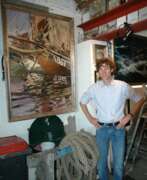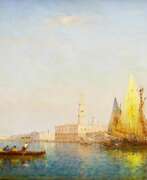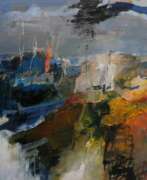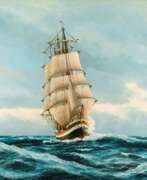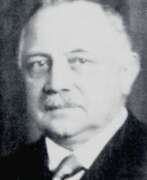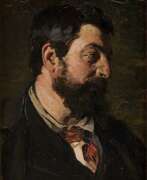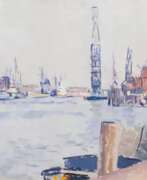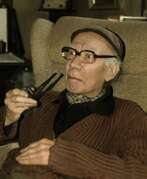Marine painters 20th century


Antonio De Simone was an Italian marine painter.
He created many paintings depicting various ships at sea: frigates, yachts, sailing ships and steamships, in the storm and with the sails down. De Simone also painted historical battle scenes, such as his famous painting - "Bombardment of Alexandria", which is in the Royal Greenwich Museums.


Lucien Adrion was a French post-impressionist painter, draughtsman and printmaker. He is known for his depictions of the French countryside and beaches, as well as of Parisian life, including landscapes, still lifes, figures and landmarks.
Throughout his career, Adrion exhibited his work at the Salons in Paris, where he was praised for his ability to capture the movement and transience of city life.
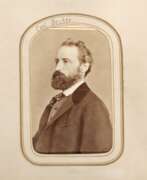

Carl Emil Rudolf Ludwig Becker was a German marine artist.
He was awarded gold medals at the International Art Exhibition of 1894, in Vienna, and the Große Berliner Kunstausstellung of 1896. Three years later, he was one of the co-founders of the Düsseldorfer Künstler-Vereinigung (artists' association). After the turn of the century, marine painting was heavily promoted by Kaiser Wilhelm II, who was attempting to make Germany a major sea power. As a result, the demand for Becker's paintings increased farther inland.
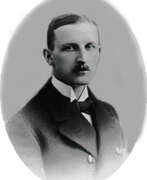

Claus Friedrich Bergen was a German painter of the first half of the twentieth century. He is known as a marine painter and illustrator.
Claus Bergen illustrated Karl May's adventure tales early in his career, creating more than 450 works. He specialized in nautical subjects, depictions of fishing and coastal landscapes, and traveled to Norway, England, the Mediterranean and America. During World War I, Bergen created paintings depicting sea battles; he was the only artist of his time to participate in a submarine raid. In World War II, he was included by the Nazis in the "God-given list" and his work was exhibited in Nazi exhibitions in Munich from 1937 to 1944.
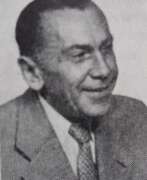

Adolf Konrad Walter Bock was a twentieth-century German painter. He is known as a marine painter.
Adolf Bock, as a sailor in the German Navy, in 1912 accompanied Emperor Wilhelm II on a voyage to the Mediterranean and received, as an artist, the support of the Kaiser. In the interwar period he carried out commissions for steamship companies, publishing houses and magazines. In Nazi Germany his work was also valued, and he received a professorship personally from Hitler. During the Second World War, the artist survived being on the port side of the sunken liner Wilhelm Gustloff and later created prints on the subject of the disaster.


Hans Bohrdt was a German marine painter and graphic artist. Bohrdt's journey into marine painting began after a visit to the Hamburg port at the age of 15, sparking a lifelong passion for the sea and maritime subjects. Unlike many artists of his time who had formal art education, Hans Bohrdt was largely self-taught, although he did attend the Academy of Fine Arts in Berlin for a period. His dissatisfaction with the conventional training led him to pursue a more hands-on approach to his art, focusing on seascapes and marine life.
Hans Bohrdt's work gained significant recognition during the Wilhelmine era, making him a celebrated figure in German marine painting, a genre that became particularly prominent after the unification of Germany in 1871. His close relationship with Kaiser Wilhelm II, who was an admirer and patron of his work, helped elevate Bohrdt's status further. Bohrdt's art was known for its technical skill, particularly in depicting the majesty of the sea and the vessels that traversed it. His pieces often featured German naval prowess and were used for both private collections and public display, contributing to national pride and naval propaganda, especially during World War I.
The legacy of Hans Bohrdt is marked by his ability to capture the spirit and grandeur of maritime life, making him a significant figure in the history of German art. Despite the challenges posed by the world wars, which led to the loss of many of his works including his best-known painting, "Der letzte Mann" ("The Last Man"), Bohrdt's art continues to be celebrated for its contribution to marine painting. In 1995, on the fiftieth anniversary of his death, a memorial exhibition was held, showcasing his contributions to the field and reaffirming his place as one of the last great marine painters.
For collectors and experts in art and antiques, Hans Bohrdt's work offers a unique glimpse into the development of marine painting in Germany, reflecting both the beauty of the maritime world and the historical context of his times. To stay informed about sales, auction events, and updates related to Hans Bohrdt's work, signing up for newsletters from galleries and auction houses specializing in maritime art and antiques is recommended. This ensures enthusiasts and collectors are well-informed about opportunities to acquire pieces by this distinguished artist.


Francois Boisrond is a contemporary French painter. He studied from 1977 to 1980 at the National School of decorative Arts. In 1981 he became involved in the Free Figuration movement. Inspired by visual products (advertising products, posters, stickers, video games etc.), cartoon characters, and by using acrylic paint, Francois Boisrond’s works are colourful, figurative and enigmatic, and his simplified shapes are often outlined in black. He portrays mainly characters, frequently symbolic in everyday situations, but he also depicts urban, maritime or rural landscapes. Besides this Boisrond creates humanitarian and publicity posters. Since the 1990’s the artist has become interested in an imaginary public and the everyday life that invades each and every one of us.


Theodore Penleigh Boyd was a British born Australian artist. Penleigh Boyd was a member of the Boyd artistic dynasty: his parents Arthur Merric Boyd and Emma Minnie Boyd (née à Beckett) were well-known artists of the day, and his brothers included the ceramicist Merric Boyd and the novelist Martin Boyd. Penleigh Boyd is best known as a landscapist with an accomplished handling of evanescent effects of light. A notable influence was artist E. Phillips Fox, who introduced him to plein air techniques when they were neighbours in Paris.


Arthur Merric Boyd was an Australian painter. He and his wife Emma Minnie (née à Beckett) established a lifestyle of being artists which many generations followed to create the popular image of the Boyd family. Boyd travelled and painted a good deal on the continent of Europe, and returned to Australia about the end of 1893, where he lived mostly in Sandringham and other suburbs of Melbourne for the rest of his life. He occasionally sent good work to the exhibitions of the Victorian Artists' Society, but never mixed much in the artistic life of his time.


Alfred Thompson Bricher was a painter associated with White Mountain art and the Hudson River School.
In the 1870s, he primarily did maritime themed paintings, with attention to watercolor paintings of landscape, marine, and coastwise scenery. He often spent summers in Grand Manan, where he produced such notable works as Morning at Grand Manan (1878). In 1879, Bricher was elected into the National Academy of Design as an Associate member.


Nikolai Evlampievich Bublikov (Russian: Николай Евлампиевич Бубликов) was a Russian and Soviet artist of the late 19th and first half of the 20th centuries. He is known as a marine and landscape painter, a representative of the Leningrad school of painting.
Nikolai Bublikov was distinguished by the use of a wide spatial perspective and a subtle range of colors in his works. He is considered the first artist who in his work raised the theme of the Soviet Navy. During the Great Patriotic War, the artist stayed in Leningrad and died during the siege of the city.
His works can be found in various museums and private collections in Russia and abroad, including the Russian Museum and the Central Naval Museum in St. Petersburg.


Georg Burmester was a German artist of the late 19th - first third of the 20th centuries. He is known as a painter, graphic artist, impressionist, representative of the Düsseldorf art school, and teacher.
Burmester worked mainly in the genres of landscape and marinas, but among his works there are also still lifes, as well as works in the genre of nude. He was a teacher at the Kassel Art School from 1912 to 1930 and was promoted to the rank of professor in 1917.


Georges-Léon-Ernest Buysse is a Belgian impressionist and luminist painter. Busset took lessons from the Ghent painter Louis Titgadt. The artist Emil Klaus, who was one of his friends, also gave him a lot of advice. He has participated in exhibitions since 1894. At the 1894 Salon of the National Society of Fine Arts in Paris, he exhibited two canvases on the theme of "snow effects". At that time, his work was focused on landscapes, views of the city of Ghent and gardens of country residences in the vicinity of Ghent. In 1904, Busset was one of the co-founders of the artistic circle Vie et Lumière. His early work was realistic or pre-impressionist. Later, his palette became - under the influence of Emile Claus and after their trip to the south of France - clearer, the work acquired impressionist and luminist features. He adhered to Luminism, in particular as a co-founder of the art circle Vie et Lumière, and used light and lighting effects in his painting.


Jacques François Joseph Carabain was a Dutch-Belgian painter, known primarily for his scenes of cities and buildings in the Romantic-Realist style. He was especially interested in Medieval and Baroque structures, and was often attracted to busy market places.
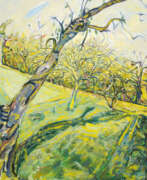

Bernard Chaet was an American artist. Chaet is known for his colorful, dynamic modernist paintings and masterful draftsmanship, his association with the Boston Expressionists, and his 40-year career as a Professor of Painting at Yale University. His works also include watercolors and prints. In 1994, he was named a National Academician by the National Academy of Design. Chaet's works are in the permanent collections of many important museums. Chaet is known for his association as a first generation Boston Expressionist. Having studied with Zerbe, a father of Boston Expressionism, Chaet's early works certainly adhere to the techniques and philosophy of the school.


Roger Chapelet, full name Albert Roger Édouard Chapelet, was a French marine painter.
Chapelet worked in the Navy Ministry, in 1927 he began painting, and in 1936 he was appointed an official marine painter and became a member of the Naval Academy. During and after World War II, Chapelet took part in numerous operations of the French Navy. During his service, he continued to paint various military operations and naval battles. After the war, he returned to civilian life and became an artist for several ship companies.
Chapelet is considered one of the greatest artists of the French Navy of the 20th century.
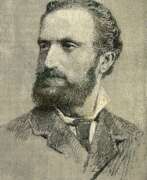

Guglielmo Ciardi was an Italian marine and landscape painter.
Ciardi graduated from the Venice Academy of Fine Arts, traveled extensively throughout the country and made sketches. These include views of the Venetian lagoon with fishing boats and the countryside around Treviso, mountain landscapes painted during his many trips to the cities of Veneto, Trentino and Lombardy.
Guglielmo Ciardi was an active participant in many exhibitions and was awarded a gold medal at the San Francisco Exposition in 1915.
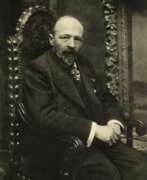

Franciscus Eduardus Maria (Franz) Courtens (1854–1943) was a Belgian painter. He was a leading figure in the Dendermonde School, famous for his paintings of nature and landscapes. Courtens was professor at the Royal Academy of Fine Arts (NHISKA) in Antwerp from 1904 till 1924. He was a personal friend of Leopold II, who gave him the privilege of free access to the royal Parc of Laeken. Some of his paintings stil remain in the Royal collection.


Alfred James Daplyn was an English-born Australian artist. Daplyn migrated to Melbourne in 1881, later becoming secretary of the New South Wales Art Society when he moved to Sydney. The Society's instructor in painting 1885-92, Daplyn influenced Charles Conder, Sydney Long and Julian Ashton.


Jean-Joseph Delvin was a Belgian painter who specialized in scenes with animals (primarily horses). He attended the Royal Academy of Fine Arts in Ghent, where he studied under Théodore-Joseph Canneel, and worked in the studios of Jean Portaels in Brussels. Later, he undertook study trips to France and Spain. For many years, he shared a small workshop in a garden shed with Gustave Den Duyts. In 1883, he was invited to join the secessionist group Les XX, but he resigned only a few years later in 1886. He was also a member of La Libre Esthétique and Kunst van Heden (Art for Today) in Antwerp. At about that time, he began teaching at the Academy in Ghent and later became its Director (1902–1913). Among his many well-known students there were Albert Baertsoen, Gustave De Smet, Frans Masereel, George Minne and Frits Van den Berghe.


Karl Edvard Diriks was a Norwegian painter.
He is known for his naturalist outdoor paintings of clouds, rain squalls, snow flurry, storms and rough seas. He is represented with thirteen works in the National Gallery of Norway, in a number of other Norwegian galleries, and in galleries in France and Germany. He was decorated Knight, First Class of the Order of St. Olav, and Officer of the French Legion of Honour in 1920.


Pieter Cornelis Dommersen, born as Dommershuisen, was a Dutch painter and watercolourist active in England.
He was the elder brother of the painter Cornelis Christiaan Dommersen. His son William Raymond Dommersen (Dommerson) (1859-1927) also became a fine art artist in England, all three Dommersens painting the same genre of paintings. Pieter Cornelis specialist in sea-, land- and river-scapes.
Works of Dommersen are present in many museums such as Amsterdam, The Hague, Rotterdam, Utrecht and many museums in the United Kingdom.




Alexander Alekseevich Efimov (Russian: Александр Алексеевич Ефимов) was a Soviet artist of the mid-twentieth century. He is known as a battle painter, marinist and teacher.
Alexander Efimov participated in the Great Patriotic War and the main theme of his work was the history of the navy. He actively worked in the studio of marinists of the fleet, in his work he used the techniques of oil painting and watercolor. His works, including the paintings "Leningradki", "Sailors in the battles for Budapest", "Northern Fleet", became famous for their historical significance.
Efimov's works are in museums and private collections not only in Russia but also abroad.




Fremont F. Ellis was an American impressionist painter who expressed a deeply intuitive perception of nature in his works.
He painted in a style strongly influenced by the Impressionists, using bold strokes and vivid colours to convey light and atmosphere in his landscapes. Being self-taught, he joined a well-known group of young Santa Fe artists, Los Cincos Pintores. For nearly 70 years Ellis drew inspiration from the beauty of New Mexico's landscapes.
Ellis' work continues to influence contemporary artists. His work has been exhibited in many galleries in New York, London and Paris. Ellis received many prestigious awards during his career, including the Julian Medal and the Gold Medal at the Paris Salon in 1930. His work is held in several museums, including the Harwood Art Museum in Taos, New Mexico, and the National Museum of American Art in Washington, D.C.


Richard Hermann Eschke was a German marine and landscape painter.
Richard Eschke became known as a pupil of his father Hermann Eschke and the Berlin Academy. Eschke lived in England for several years, where he made studies for a number of paintings.
Richard Eschke was awarded the small gold medal of the Berlin Art Exhibition.


Hermann Wilhelm Benjamin Eschke was a German painter of the second half of the 19th century. He is known as a marine painter.
Hermann Eschke began his career by traveling through southern France and the Pyrenees, after which he became a free-lance artist, creating sketches and designs while traveling in Europe. In collaboration with his son Richard Eschke, the master created murals and dioramas, including works for the Imperial Panorama in Berlin. His contribution to art was recognized with honors and medals, including the title of "Royal Professor" and the gold medal of the Berlin Artists' Association.


Alfred William (Willy) Finch was a ceramist and painter in the pointillist and Neo-Impressionist style. Born in Brussels to British parents, he spent most of his creative life in Finland. In 1883 he became a founding member of Les XX, a group of twenty Belgian painters, designers and sculptors, who rebelled against the prevailing artistic standards and outmoded academism. He was impressed by the works of Georges Seurat and Paul Signac and changed his own painting style from a more realistic approach into a pointillistic style. In the following years, Finch became one of the leading representatives of his style in Belgium, along with Théo van Rysselberghe. During the early 1890s Finch switched careers from painting to pottery, upon the realization that he couldn't make a living by painting. In 1897, invited by count Louis Sparre, Finch moved to Porvoo, Finland, to head the Iris ceramics factory, and influenced the development of the local Jugendstil. After the factory was closed, Finch resumed his painting career.


William Teulon Blandford Fletcher is a British artist and one of the early members of the influential Newlyn School of Artists. He joined the Lyfe class at the Royal Academy of Charles Wehrle in Antwerp.
Blandford Fletcher travelled and worked as an itinerant artist until settling in Dorking in 1904 and then in Abingdon-on-Thames in 1915. Fletcher's best known work is Evicted (painted in Steventon in 1887), the first painting acquired by the Queensland Art Gallery in 1896.


Poppe Folkerts was a German marine painter, draughtsman and graphic artist. He studied at the Berlin Academy of Fine Arts under Karl Salzmann. In 1907 and 1908 he studied figure and portrait painting in Düsseldorf with Eduard von Gebhardt, before going to Paris in 1909, where he was accepted at the Académie Julian.
Poppe Volkerts is considered one of the most outstanding artists of the Frisian coast. As an enthusiastic sailor, he was able to capture the peculiarities of this landscape, the struggle of people with the forces of nature and the fascination of the sea with its constantly changing weather conditions and moods, with a unique liveliness and intensity. His pastose application of paint, special lighting and pure colours create the spatial depth and radiance inherent in the paintings.


Detlev James Foth is a German painter. He studied free painting at the Düsseldorf Art Academy from 1979 to 1985. During the second semester his first solo exhibition took place at the Galeria de Arte Sala Goya in Palma de Mallorca, Spain. In 2001 he received an invitation from the Foreign Office in Berlin to hold a solo exhibition at the German Business Club in São Paulo, Brazil. He was the first German artist to have a solo exhibition at the Portuguese Cultural Institute (Instituto Camões) in Luanda, Angola. In 2012 the painter had, among other things, a solo exhibition at the Arthropologie Gallery, Cairo, Egypt. His works can be found in private collections and in public spaces. In addition to painting, Detlev Foth deals with literature and has published numerous plays, novels, short stories and poems.




Karl Gatermann the Elder was a German painter and graphic artist. He was the uncle of artist Karl Gatermann, who is typically called "Karl Gatermann the Younger" to distinguish between the two. In 1910 he received the First Prize for Painting of the City of Munich for the oil painting Life. From 1919 to 1942 he lived and worked in Lübeck. In Berlin in 1923 and 1925, he exhibited his watercolors in the galleries of Rudolf Wiltschek and in the Kunsthaus Heumann in Hamburg in 1926. Gatermann's watercolors were also shown in England and in the London Times. Gatermann predominantly focused on north German landscapes and cities, though he also painted still life and figurative scenes, and portraits of people.
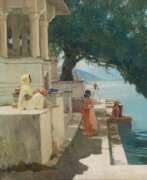



Frauke Gloyer is a contemporary German artist. She studied freehand painting at the University of Fine Arts in Braunschweig. She has been working as a freelance artist since 1988.
Frauke Gloyer's work includes expressionist landscapes, still lifes, portraits and animal studies.


Antonio Gravina was an Italian painter. He was born in Naples and studied at the Art Institute in that city. The setting, the chromatic range, makes his work a valuable item to collectors the world over. His subjects are hugely varied. Quiet bays bathed in sunlight, the fishermen carefully mending their nets, the transparent emerald sea reflecting the clear sky; or his paintings of stormy seas, portrayed with vivid, essential, sharp brush strokes, those heavy grey skies warning of an imminent storm. Unforgettable too, his restful spring time parks, his characteristically colourful Parisian bistro customers, his sunny cottage scenes with their softness and warmth. All his paintings bring to mind the masterpieces of the great 18th century artists, and yet his work is very much of the 21st century. He has had 48 exhibitions in Rome, Naples, Frankfurt, Sydney and Vancouver as well as occasional ones at Stewart Gallery in England.


Carlos (Carl) Conrad Grethe was a Uruguayan-born German painter and academician. Grethe was born in Montevideo, Uruguay, but lived in Hamburg from the age of five. He studied at the Fine Arts School of Paul Düyffcke at the Karlsruher Kunstakademie, as well as the Parisian Académie Julian from 1884 to 1886. He interrupted his studies for almost a year to undertake a sea voyage to Mexico in 1888 and 1889. From 1894, Grethe was a member of the Munich Secession, and was also involved in the founding of the Karlsruher Künstlerbundes in 1896, the Stuttgarter Künstlerbundes, (the State Academy of Fine Arts in Stuttgart) in 1901, and the Verein Württembergischer Kunstfreunde. By the turn of the century Grethe had become prominent in representations of man and the sea, as well as of coasts and ports. His artistic style developed from a commitment to modern realism at the beginning of his career to a rather more impressionistic style in his later works.


Hermann Grobe was a German maritime painter.
He studied at the Munich and Düsseldorf Art Academies. His favorite subject for Grobe was the sea and everything connected with it. He painted a lot of pictures with ships on the pier and everyday scenes on the shore, sailors on the shore and fishing boats.




Anton Gutknecht was a German-American landscape painter known for his maritime seascapes of southern California and rural Europe. With a particular interest in the tumultuous nature of the ocean, the artist often focused on capturing waves crashing on the shore or on the boughs of a ship rendered in a high level of realistic detail. Gutknecht spent his early life traveling between different areas of the country, notably Munich and Hamburg, observing the mountainous terrain that would later be the focus of his work and bring him recognition. Gutknecht taught at the Royal Academy in Vienna before frequently traveling to southern California in the 1930s, eventually moving there to settle in Palm Springs and focus on capturing the landscape there.


Johannes Friedrich Heinrich Hänsch was a German landscape painter and sculptor. Hänsch was born as the son of the sculptor Adolf Hänsch and his wife Johanna (nee Lehmann). He began his artistic training in his father's studio and initially continued it in the workshops of other sculptors before he decided to become a painter. On December 11, 1897, he began studying at the "Royal Academy of Fine Arts" in Berlin. As a freelance landscape painter, he was a member of the “Berlin Artists Association”. Since 1903, Hänsch has taken part in the Great Berlin Art Exhibition as well as in the exhibitions of the Association of Berlin Artists and in the Munich Glass Palace. His colorful painting showed a clear influence of Impressionism. He painted almost exclusively deserted landscapes from all parts of Germany. Paintings depicting human figures were a rare exception, but he did produce some mostly witty self-portraits.
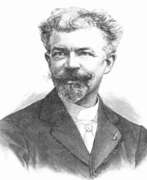

Georges Jean Marie Haquette was a prominent French painter, particularly known for his portrayals of fishermen and maritime scenes. Born in Paris, Haquette trained under notable 19th-century artists Aime Millet and Alexandre Cabanel, drawing influence from French Realist painters like Courbet. His unique focus was on the lives and labors of sea harvesters, differentiating his work from contemporaries who focused more on land-based peasants.
Haquette debuted at the Paris Salon in 1875 and continued to exhibit there, earning various recognitions including an honorable mention in 1878 and medals in 1880 and 1901. His notable works include "Un homme à la mer!" (1886), "La femme du matelot" (1887), and "La levée des filets" (1888). His painting "Net Fishers" was featured in "Famous Paintings of the World" (1894), emphasizing the picturesque and labor-intensive life of coastal peasants.
Many of Haquette's works are housed in prestigious museums, such as those in Brest, Dieppe, Mulhouse, Pontoise, and Rouen. Some of his notable paintings include "Le Manchon de Francine" in the Musée de Brou, "Pêcheurs" in the Musée du Vieux Château, and "Pêcheuse" in the Hôtel de Ville de Rouen.
For collectors, auctioneers, and art and antiques experts interested in Haquette’s work, his paintings represent an insightful view into 19th-century French maritime life and culture. His unique focus on sea harvesters adds a distinctive dimension to French Realist painting.
To stay updated on new product sales and auction events related to Georges Jean Marie Haquette, consider signing up for relevant updates. This subscription will keep you informed about important developments and opportunities in the world of Haquette’s art.
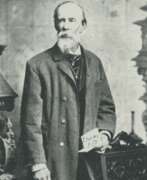

Edwin Hayes was an English and Irish marine painter, a member of the Royal Institution of Painters and Aquarists, and of the Royal Academy of Arts.
He studied art at the Dublin Society School of Art. A voyage across the Atlantic in his youth made an indelible impression on Hayes: his work invariably depicted ships and boats on the high seas. Over the course of his life, Hayes produced many seascapes, each with its own unique beauty.
His son Claude Hayes (1852-1922) was also a famous landscape and portrait painter.


Bernard Benedict Hemy is an English marine painter.
He was born in Australia, but his family soon returned to the United Kingdom, to Newcastle-upon-Tyne. Like his painter brothers, Bernard Hemy studied painting at the Newcastle School of Art. He specialized in depictions of the daily activities of fishermen, realistically documenting fishing scenes, coastal and harbor views, ships and sailing boats.


Ernest Martin Hennings (Jr.) was an American artist and member of the Taos Society of Artists. In 1901 that Hennings began taking classes at the School of the Art Institute of Chicago, which was largely based on the great European art schools and made particularly emphasis on the importance of drawing. Hennings took up work as a commercial artist, mostly painting murals and portraits around Chicago. Hennings' primary interest was in portrait painting, with his primary subject being the Native Americans living in and around Taos Pueblo. In 1922 he was awarded the Clyde M. Carr Prize from the Art Institute of Chicago as well as the Institute's Fine Arts Building Prize. By the 1920s, the now established painter was building his reputation on the national scene, with exhibitions and awards including. Many art collectors throughout America sought out his paintings. Today paintings by Hennings are housed in the Smithsonian American Art Museum, Stark Museum of Art, Booth Western Art Museum etc.


Franz Carl Herpel was a German painter of the last quarter of the nineteenth and first third of the twentieth centuries. He is known as a marine painter.
Herpel was born in Voronezh in the Russian Empire and returned to Germany with his family. He graduated from the Königsberg Academy of Arts and his works were regularly exhibited in Munich, Hanover, Dresden and other German cities. At the end of the XIX century the artist was invited to Turkey and worked in Constantinople, fulfilling the orders of the Turkish sultan. He was an active member of the German Yacht Club and traveled extensively on his personal yacht, which was reflected in his nautical works.


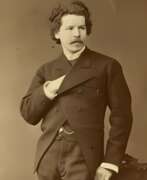

Oskar Georg Adolf Hoffmann (Russian: Оскар Адольфович Гофман) was a German painter known for his tranquil and detailed landscape paintings. Born in 1851, Hoffmann specialized in capturing the serene beauty of nature, often depicting forest scenes, rivers, and pastoral settings with remarkable precision.
Hoffmann’s work is distinguished by its meticulous attention to detail and a deep appreciation for the natural world. His paintings often feature lush greenery, reflective water bodies, and soft, diffused light, creating a sense of peacefulness and calm. Hoffmann's ability to portray the subtle nuances of light and shadow made his landscapes particularly captivating.
Some of Hoffmann’s notable works are displayed in various European museums and galleries, admired for their technical excellence and tranquil beauty. His pieces continue to attract collectors and art enthusiasts, drawn to his masterful representation of nature’s serenity.
For those interested in acquiring or learning more about Oskar Georg Adolf Hoffmann’s works, signing up for updates on new product sales and auction events is highly recommended.


















